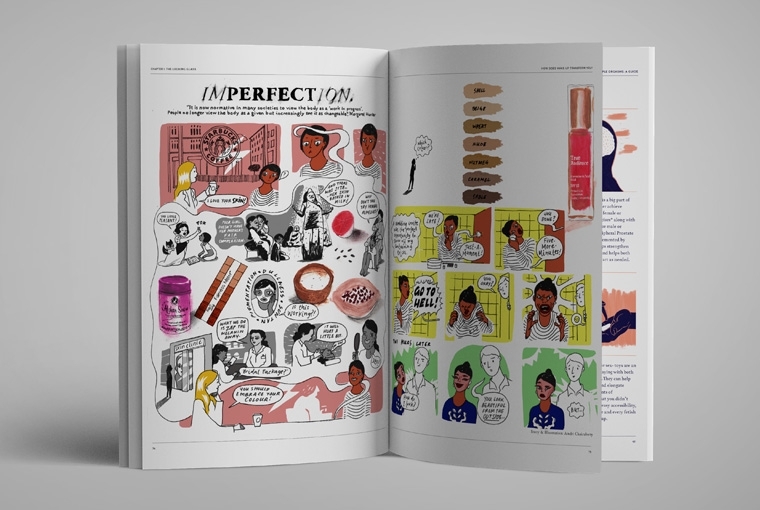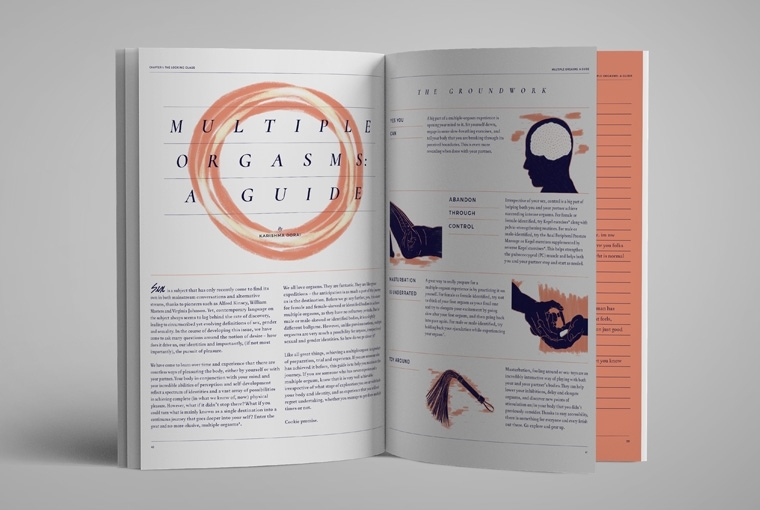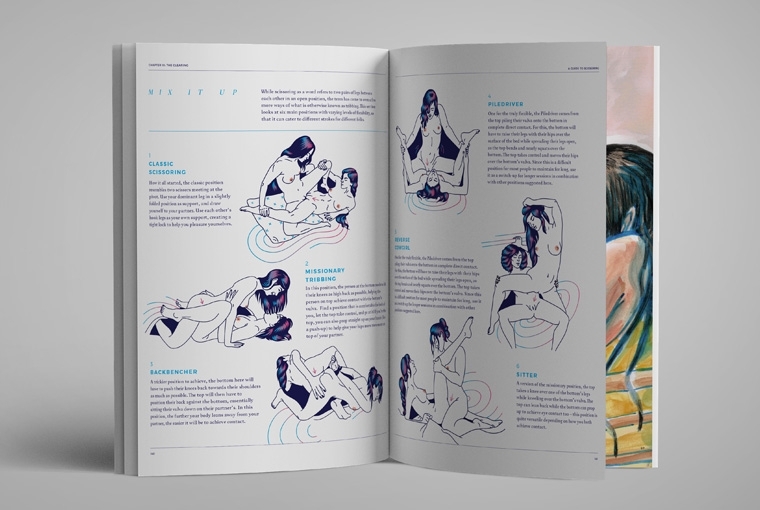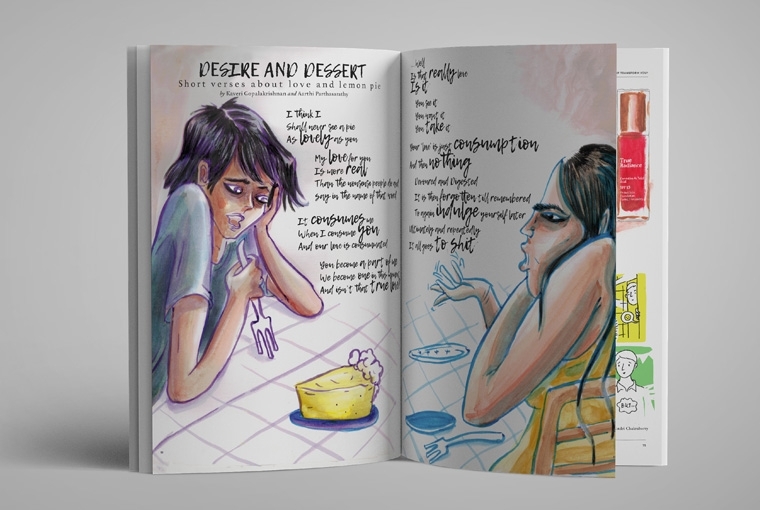

All That We Want
The fifth edition of The Gaysi Zine embarks on a journey to explore the unchartered realm of queer desires, and does so, with effortless grit. What are our desires? How do we discover them? And how do they drive and shape our lives, and more importantly, who we are today? These are just some of the questions that the gripping, beautifully illustrated zine sets out to answer. 'This issue of the zine is a conscious acknowledgement and expression of our queer desires. It aims to talk about desire and experience through the experience of others, and give it a voice in a space where our desires have been declared illegal. We legitimise that which has been illegitimised by giving it a continuum of expression,’ says Priya Gangwani, the editor of The Gaysi Zine. The multilayered narrative unfolds through fiction, non-fiction, visual stories, memoirs, photo essays, poetry and graphic how-to guides.
Desiderata by Anar-e-Sistanem is a stirring account of uncovering and quenching her desires, only to realize that it was a realm, where at every turn of the road lay a new discovery. Aindri Chakrabarty’s graphic story is an enquiry into how make-up transforms us and how sometimes, the act of prettying up leaves us so baffled. Dhrubo Jyoti’s Never Lost, Never Found paints his story – that of being 27, fat, lower caste, queer and filled with desires that took him a long time to understand. At its very core, this zine is about unraveling the things that move us and shape us, queer or not. It is a celebration of everything that makes us human. But most importantly, it marks the beginnings of the kind of radical, alternative and fiercely intimate literature that India desperately needs more of. A couple of lines penned by Anar-e-Sistanem stay with me, long after I’ve flipped to the last page. ‘I desire frenzy and peace. I desire the quotidian and the celebratory. I desire sex and love. I desire to be owned and liberated. I desire the sacred and the profane. I desire the US and the I. I desire to lead and to be lead. I desire strength and vulnerability. I desire to run and walk. I desire to burn and to be burnt. What is most difficult is I crave for all of this, all at the same time.’ Don’t we all?
I connect with the editor and the designer of the zine and they take me through the little nuances that shaped All That We Want. In conversation with Priya Gangwani and Karishma Dorai.
The previous issues were a larger exploration of narratives spanning queer culture. What shaped the thematic approach to this edition?
PG: We always wanted to try a theme-based issue for it sincerely creates a space to explore the many complex layers that makes up people, societies, and it’s sub-cultures. Reflecting back on the previous four issues, we realized that all of us have grown as individuals and as a community. It seemed that we were ready to look carefully at the integral aspects of queer lives. We thought that if we paid attention, and only merely focused on that one aspect, we might touch upon a golden lantern. And that is how the subject of desire for this issue came about. Our desires are what separate us from others. At the same time, we all desire despite being told not to.
KD: The last four issues brought together various stories under each, in a manner similar to how we have run the Gaysi blog for the last eight years. The blog started off as a space for stories, both personal and collective, and the zine became an offline expression of that premise, as we imagined print as more permeable than digital in our country and beyond, even with rapid digital adaptation. It had this sense of permanence, no matter the narrative.

A graphic story written and illustrated by Aindri Chakraborty
However, over time, we noticed a need for critical inquiry into particular subjects that make the queer collective in both mediums (online and offline). How are we responding to a post-377 environment after nearly 4 years? Are prejudices retreating, or growing? How do we navigate the inclusion of our wants in a society where our wants are outlawed or ‘othered’? Does being ‘othered’ even matter anymore – is it now another sub-cultural state of resistance that we express through literature, art, music etc.?
While we have been exploring this offline via events and discussions (Read Out Loud, Kink Workshop, LBT safe spaces and more), the need to push the zine to observe and focus its narrative became more pronounced with this issue. While it’s something we’ve always wanted to do – curate around specific contexts, this seemed like the right time to do it. We threw a few ideas around and nothing evoked more debate and polarization than the topic of desire. And in that moment of absolute disagreement, we decided to go forward with it.
How does the latest zine explore the whole gamut of desire? What were the different perspectives you approached to deconstruct and understand such a complex sense of longing?
PG: This issue presents a wider field, and embraces a greater diversity of perspectives on the subject of queer desires. The narratives we see are not those of popular imagination but very intimate and personal. This issue illuminates the relationships between desires recognised in the self, desires being performed in both personal and private spaces, and acknowledging the different experiences of our desires in it’s many forms.
The subject of queer desires is also explored through different literary genres and visual representations: personal testimonies, fiction, graphic narratives, illustrations, poetry and photo essays.
However, what makes this issue special is that all pieces treat the subject of desire outside the physical realm of sex, sensuality, and lust.
KD: One of our biggest challenges was breaking open the dry wall to extend beyond sex and sensuality as the expression of desire, and turn it into an expression of desire. We put together a few angles we definitely wanted in the zine – desire and disability, desire as a lens of self-discovery, desire as a tool of professional productivity, so on and so forth – angles that pushed us, and hopefully the reader, to look at the importance and power of desire in a manner different to its normal attributes. In the course of doing so, we discovered two things. One, there is so much that Queer offers as perspective/view/observation on desire, because of the nature of how it permeates our existence, and our identities. Second, it would be nearly impossible to cover all of that in a single issue. We imagine that these various perspectives on desire are living things, that they grow every day based on our experiences, understandings, learnings. As a result, we decided to chapter the issue into three parts, a structure that might extend into future issues on the subject, as Priya has elaborated. This is a first step in deconstructing, understanding and probably studying desire from a larger perspective, serving as an inquiry through personal accounts, art, design, graphic narratives and more.

Multiple Orgasms: A Guide by Karishma Dorai
I read somewhere that this edition aims to talk about queer desires consciously in the Indian context. Can you please elaborate?
PG: The question of morality attached to sexuality is very specific in the Indian context. Sex is not meant for pleasure or amusement but for procreation. In the Indian context, sex and sexuality is a matter of sacred work. Here male and female genital organs are worshipped in the forms of gods and goddesses, but the society is not open to conversations about sex and sexuality. If you look closely, you’d realize that people do not even have the language for it – not even in popular imaginations. Where Desire is not accepted even in heterosexual relationships, where is the space for the alternative? The whole notion of morality is tightly stitched into the very fabric of Indian culture. What the authors of this issue have done is taken personal risks, and found crevices in this fabric to talk consciously about their intimate queer desires. Despite all the taboo, and sexuality regularized by law and customs; they have found the language to talk about the intricate aspect of desires.
KD: There is a certain dichotomy about desire in our society. On one hand, it is criminalized and penalized, and on the other hand, it is revered, worshipped and sometimes feverishly practiced. We deal with desire like we deal with secrets. It was important to push ourselves to not talk about desire as a secret or something that happens under the sheets, but to pull those sheets off and look at it as more common than we imagine it to be, but uncommon in how we imagine it to be.
Take me through some of the headlining narratives from the zine and the sentiments they try to share.
PG: The best ones are those that get imprinted long after they have been read, and unfortunately, that seems to be the case for every narrative in this issue.
But If I were to still pick a few…Michael Giangrasso’s Lust for Life: Balbir Krishan is a raw and honest biographical piece on the artist and queer activist Balbir Krishan, and speaks of the heart-wrenching lust to live and fight all battles. Rosalyn D’Mello’s Cities of the Interior is a quasi-feminist rambling about masturbation.
Abeer Hoque marries the two forms of writing she loves – sex and travel, into this fictional piece Hourglasses which is a story about two lesbians in Dhaka, resonates beautifully with the fear of following one’s hearts desires. Dhrubo Jyoti’s Never Lost, Never Found tenderly shows the journey they took while navigating their desires through the intersectional ties of class, caste and a reality of being raised by two women!
Parvati Sharma’s Writing Desire speaks of her own coming to terms with queerness, and then her desire to be able to write about it. The how-to guides on scissoring and multiple orgasms by Karishma Dorai captures the desire to seek pleasure from the faculties of the mind and body.
KD: All these narratives are important on their own, and offer unique perspectives that together form a sum of parts for the theme. Desiderata is a wonderful account of a very personal journey, where desire takes you by surprise. Aindri Chakraborthy’s piece on make-up as a transformational tool observes our engagement with tools of masking as tools of empowerment. Soumitro Datta writes an unusual yet necessary fiction that toes between fantasy, sci-fi and reality in a crisp, three-part piece. Abeer Hoque’s protagonist reflects upon their encounters and how they transform through those experiences. They’re all individually powerful, and we feel personally connected to every one of them.

A guide to scissoring illustrated by Tanya Eden
How difficult or easy was it to get your contributors to open up about their deepest desires? How were the different narratives strung together to shape All That We Want?
PG: The one thing that was truly difficult was to not fall into the trap of looking at desire from the physical/sexual context. We were afraid that this issue might become a mere collection of erotic stories, further stereotyping and generalizing the queer community within the parochial perspective of sensuality and lust.
Karishma and I had long (sometimes very very long) discussions on the various facets of queer desire, what it meant to us, and others with different identity politics and we were often met with our own limited understanding of the subject. However, the conversations changed and evolved when we started talking to prospective contributors. The contributors of this issue were more than willing to open their secretly held stories inspite of their nagging fear of what the locals might say. This issue in many ways is still just touching the surface of the deeply hidden and not spoken about queer desires. But, we hope that it initiates an unlocking of much of that.
KD: The contributors made this issue what it is by being incredibly honest and creative. We had a certain roadmap of the sort of stories/views we were seeking, and the contributors had just the material we were looking for. It worked out quite perfectly actually. While we had some sense of a skeleton of pieces, the final bunch of pieces went far beyond our expectations, thanks to them. They worked with us through the editing process to sharpen and produce what you now see.
When you look back at your journey, how do you think the zine has evolved over the years? Where does it go next?
PG: The zine has evolved multi-fold over the years. And to be very honest – the zine is just a mere reflection of the Indian queer society. From queer language to queer identities, from personal to community testimonies – the field has widened and evolved. Unlike newspapers and many media platforms that are still debating coming out stories and identity politics, the zine is a far more refreshing and honest documentation of lived realities of people.
And if one were to solely look at the journey of The Gaysi Zine, the content and the narratives are now expressed through different literary and visual mediums: personal accounts, poetry, illustrations, graphic narratives, photo essays, and non-fiction, which is an evolution from the previous issues.
KD: The zine has evolved on various counts, the most important being the manner of documentation of queer lives. As we grow by each issue, we realise the importance of how we’re bringing these stories together, whether its through design, curation or editing. From a largely written documentation, the zine is now diverse in its creative expression, from graphic narratives and illustrations to poetry and spoken word. What’s next is understanding how we can narrow the gap between digital and print with our future issues in the way we tell our stories.

Desire and Dessert by Kaveri Gopalakrishnan and Aarthi Parthasarathy
What does 2017 have in hold for you?
PG: Personally, I want to create one project, at Gaysi, which will help recover queer history. I often wonder about the era of 80s and 90s, the pre-mobile and Internet days. I am deeply curious to know what language people used to describe their identities, how they found each other and how did they navigate their love and desires.
At Gaysi, 2017 is the year where we intend to create more LBT-focused initiatives both online and offline.
KD: 2017 has quite a bit in store – the exploration of LBT-focused initiatives across online and offline mediums and a look at understanding how we can provide digital experiences to the LGBTQIAPK community. We are individually exploring projects that cater to our strengths and hope to reveal it soon to the world at large.
Pick up your copy of All That We Want here.
Text Ritupriya Basu